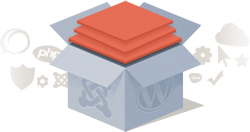Tutorial #1: Launching & Accessing Your Free WordPress Site
CloudAccess.net has taken the second guessing out of launching your own server, configuring a database and installing WordPress. We do all this work for you and put WordPress in your hands immediately. This tutorial demonstrates how to launch and access your free WordPress site.
Tutorial #2: WordPress Dashboard Overview
There are two parts of every WordPress site: the front end (the public facing view) and the Dashboard (the administration area). The Dashboard enables you to manage posts, pages, comments, themes and more. Watch the video below to get an overview of the WordPress Dashboard.
Tutorial #3: Using WordPress Themes
WordPress themes control the visual look, layout and feel of the front end of the site. There are several themes installed in your site when you launch it and there are many more available in the WordPress community. This tutorial demonstrates how to locate, install, activate and customize a theme.
Tutorial #4: WordPress Posts vs. Pages
WordPress has two basic types of content: Posts & Pages. Posts usually contain a continually updated stream of content like a blog. Pages are usually used for static pages that don't change all that much. This tutorial explains the difference between WordPress Posts and Pages.
Tutorial #5: Organizing WordPress Content: Creating Categories
Before creating content for your WordPress site, it's good to know a little about how WordPress organizes content in the dashboard. This tutorial demonstrates how to create categories for WordPress posts and how to change the default category for posts.
Tutorial #6: Creating WordPress Posts
WordPress was originally created as a blogging/posting platform, and many additional features have been added over time, but the original blogging/posting feature is still the core of WordPress. This tutorial demonstrates how to create, preview, save and publish WordPress posts and how to use the tags feature.
Tutorial #7: WordPress Text Formatting
WordPress has many tools within the native text editor making text formatting very easy. Many of these features you'll be familiar with if you have used any word processor in the past, but you many not be familiar with all features. The tutorial demonstrates several text formatting features available in WordPress.
Tutorial #8: Media in WordPress: Embedded Images, Image Galleries & Featured Images
Adding images and other forms of media to your content is very important because you can demonstrate concepts, share images or bring life to content. This tutorial demonstrates how to incorporate media into WordPress including embedded images, image galleries and featured images.
Tutorial #9: Creating WordPress Pages
WordPress pages are meant for more easily-accessible, mostly static content like an "About Us" page or a static front page. This tutorial demonstrates how to create a new WordPress page and how to change the front page of the site from a stream of your posts to a static page.
Tutorial #10: Creating Menus in WordPress
By default, when creating a page in WordPress, the page is automatically added as a menu item in the top primary menu of your site. This tutorial demonstrates how to create a custom menu in WordPress that overrides these default settings.
Tutorial #11: Creating Sub Menu Items (Drop Down Menu Items) in WordPress
In previous tutorials in this series we've demonstrated how to create WordPress pages & menus. This tutorial demonstrates how to create ghost menu items (menu items that don't link to anything) and how to create sub menu items (also referred to as drop down menu items) in WordPress.
Tutorial #12: Using WordPress Widgets
WordPress widgets provide additional core functionality to the WordPress site and each theme offers different widget-ready areas. This tutorial demonstrates how to use and manage WordPress widgets.
Tutorial #13: Using WordPress Plugins: Installing a Contact Form
One of the best parts about WordPress is that you can browse through the WordPress Plugin Directory to locate additional applications to enhance the functionality of your site. This tutorial demonstrates how to use the WordPress Installer to install a plugin.
Tutorial #14: Renewing Your Free WordPress Site
Each free site launched on the CloudAccess.net platform will remain active indefinitely as long as you renew the site once every 30 days within the Cloud Control Panel™(CCP). This tutorial demonstrates how to log into the CCP to renew the site.

Do you have suggestions for improving this article?
We take a great deal of pride in our knowledgebase and making sure that our content is complete, accurate and useable. If you have a suggestion for improving anything in this content, please let us know by filling out this form. Be sure to include the link to the article that you'd like to see improved. Thank you!


